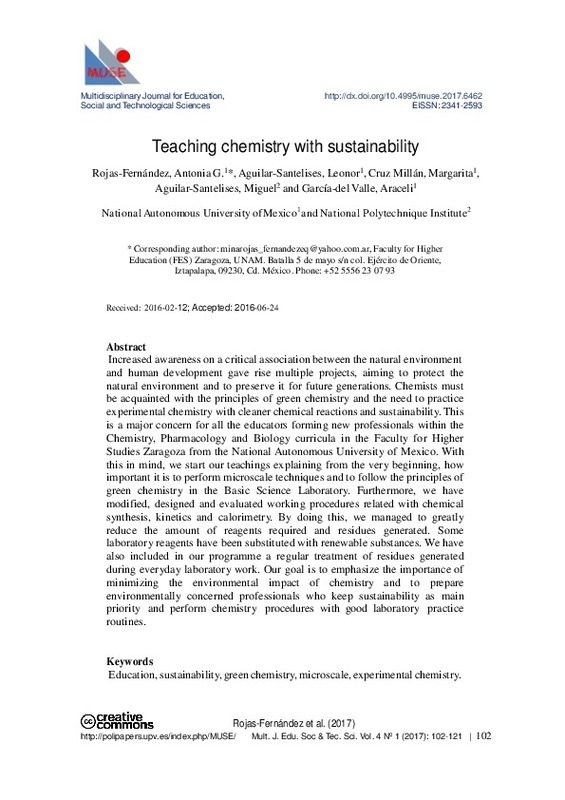JavaScript is disabled for your browser. Some features of this site may not work without it.
Buscar en RiuNet
Listar
Mi cuenta
Estadísticas
Ayuda RiuNet
Admin. UPV
Teaching chemistry with sustainability
Mostrar el registro sencillo del ítem
Ficheros en el ítem
| dc.contributor.author | Rojas-Fernández, Antonia G.
|
es_ES |
| dc.contributor.author | Aguilar-Santelises, Leonor
|
es_ES |
| dc.contributor.author | Cruz Millán, Margarita
|
es_ES |
| dc.contributor.author | Aguilar-Santelises, Miguel
|
es_ES |
| dc.contributor.author | García -del Valle, Araceli
|
es_ES |
| dc.date.accessioned | 2017-04-18T11:37:40Z | |
| dc.date.available | 2017-04-18T11:37:40Z | |
| dc.date.issued | 2017-04-10 | |
| dc.identifier.issn | 2341-2593 | |
| dc.identifier.uri | http://hdl.handle.net/10251/79736 | |
| dc.description.abstract | [EN] Increased awareness on a critical association between the natural environment and human development gave rise multiple projects, aiming to protect the natural environment and to preserve it for future generations. Chemists must be acquainted with the principles of green chemistry and the need to practice experimental chemistry with cleaner chemical reactions and sustainability. This is a major concern for all the educators forming new professionals within the Chemistry, Pharmacology and Biology curricula in the Faculty for Higher Studies Zaragoza from the National Autonomous University of Mexico. With this in mind, we start our teachings explaining from the very beginning, how important it is to perform microscale techniques and to follow the principles of green chemistry in the Basic Science Laboratory. Furthermore, we have modified, designed and evaluated working procedures related with chemical synthesis, kinetics and calorimetry. By doing this, we managed to greatly reduce the amount of reagents required and residues generated. Some laboratory reagents have been substituted with renewable substances. We have also included in our programme a regular treatment of residues generated during everyday laboratory work. Our goal is to emphasize the importance of minimizing the environmental impact of chemistry and to prepare environmentally concerned professionals who keep sustainability as main priority and perform chemistry procedures with good laboratory practice routines. | es_ES |
| dc.description.sponsorship | This project was supported by UNAM (DGAPA PAPIME PE210815). | |
| dc.language | Inglés | es_ES |
| dc.publisher | Universitat Politècnica de València | |
| dc.relation.ispartof | Multidisciplinary Journal for Education, Social and Technological Sciences | |
| dc.rights | Reconocimiento - No comercial - Sin obra derivada (by-nc-nd) | es_ES |
| dc.subject | Education | es_ES |
| dc.subject | Sustainability | es_ES |
| dc.subject | Green chemistry | es_ES |
| dc.subject | Microscale | es_ES |
| dc.subject | Experimental chemistry | es_ES |
| dc.title | Teaching chemistry with sustainability | es_ES |
| dc.type | Artículo | es_ES |
| dc.date.updated | 2017-04-18T10:45:45Z | |
| dc.identifier.doi | 10.4995/muse.2017.6462 | |
| dc.relation.projectID | info:eu-repo/grantAgreement/UNAM/PAPIME/PE-210815/MX/Fortalecimiento de la docencia del área de bioquímica de la carrera de QFB de la FES Zaragoza, mediante el desarrollo de habilidades de los profesores en el uso de las TIC y su incorporación al proceso enseñanza aprendizaje/ | |
| dc.rights.accessRights | Abierto | es_ES |
| dc.description.bibliographicCitation | Rojas-Fernández, AG.; Aguilar-Santelises, L.; Cruz Millán, M.; Aguilar-Santelises, M.; García -Del Valle, A. (2017). Teaching chemistry with sustainability. Multidisciplinary Journal for Education, Social and Technological Sciences. 4(1):102-121. https://doi.org/10.4995/muse.2017.6462 | es_ES |
| dc.description.accrualMethod | SWORD | es_ES |
| dc.relation.publisherversion | https://doi.org/10.4995/muse.2017.6462 | es_ES |
| dc.description.upvformatpinicio | 102 | es_ES |
| dc.description.upvformatpfin | 121 | es_ES |
| dc.type.version | info:eu-repo/semantics/publishedVersion | es_ES |
| dc.description.volume | 4 | |
| dc.description.issue | 1 | |
| dc.contributor.funder | Universidad Nacional Autónoma de México | |
| dc.description.references | Anastas P.T. and Warner J.C. (1998). Green Chemistry. New York: Oxford University Press. | es_ES |
| dc.description.references | Bybee, R. W. (1991). Planet Earth in Crisis: How Should Science Educators Respond? The American Biology Teacher, 53(3), 146-153. doi:10.2307/4449248 | es_ES |
| dc.description.references | Cannon, A. S., & Warner, J. C. (2011). The Science of Green Chemistry and its Role in Chemicals Policy and Educational Reform. NEW SOLUTIONS: A Journal of Environmental and Occupational Health Policy, 21(3), 499-517. doi:10.2190/ns.21.3.m | es_ES |
| dc.description.references | Carson R. (1962). Silent Spring. Fawcett Publications Inc. Greenwich, Conn. | es_ES |
| dc.description.references | Fisher, M. A. (2011). Chemistry and the Challenge of Sustainability. Journal of Chemical Education, 89(2), 179-180. doi:10.1021/ed2007923 | es_ES |
| dc.description.references | Luque R. (2012). Green Chemistry, Chemistry research and applications. Nova Science Publishers. | es_ES |
| dc.description.references | Morales-Galicia M.L., Martínez J.O., Reyes-Sánchez L.B., Hernández O.M., Arroyo Razo G.A., Valdivia A.O. (2011). ¿Qué tan verde es un experimento? Educ. Quim. 22: 240-248. | es_ES |
| dc.description.references | Perkins Marsh G. (1864). Man and Nature: or physical geography as modified by human action. Kessinger Publishing co., Whitefish, Montana, USA. | es_ES |
| dc.description.references | Singh, M. M., Szafran, Z., & Pike, R. M. (1999). Microscale Chemistry and Green Chemistry: Complementary Pedagogies. Journal of Chemical Education, 76(12), 1684. doi:10.1021/ed076p1684 | es_ES |
| dc.description.references | Stewart, A. F., Williams, A. L., Lofgreen, J. E., Edgar, L. J. G., Hoch, L. B., & Dicks, A. P. (2015). Chemistry Writing Instruction and Training: Implementing a Comprehensive Approach to Improving Student Communication Skills. Journal of Chemical Education, 93(1), 86-92. doi:10.1021/acs.jchemed.5b00373 | es_ES |
| dc.description.references | Vilches A., Gil-Pérez D. (2011). Papel de la Química y su ense-anza en la construcción de un futuro sostenible. Educ. Quim. 22: 103–116. | es_ES |
| dc.description.references | Vilches, A., & Gil Pérez, D. (2013). Ciencia de la sostenibilidad: Un nuevo campo de conocimientos al que la química y la educación química están contribuyendo. Educación Química, 24(2), 199-206. doi:10.1016/s0187-893x(13)72463-7 | es_ES |
| dc.description.references | Watson, W. J. W. (2012). How do the fine chemical, pharmaceutical, and related industries approach green chemistry and sustainability? Green Chem., 14(2), 251-259. doi:10.1039/c1gc15904f | es_ES |
| dc.description.references | Wright, S. W. (2002). Tick Tock, a Vitamin C Clock. Journal of Chemical Education, 79(1), 40A. doi:10.1021/ed079p40a | es_ES |








